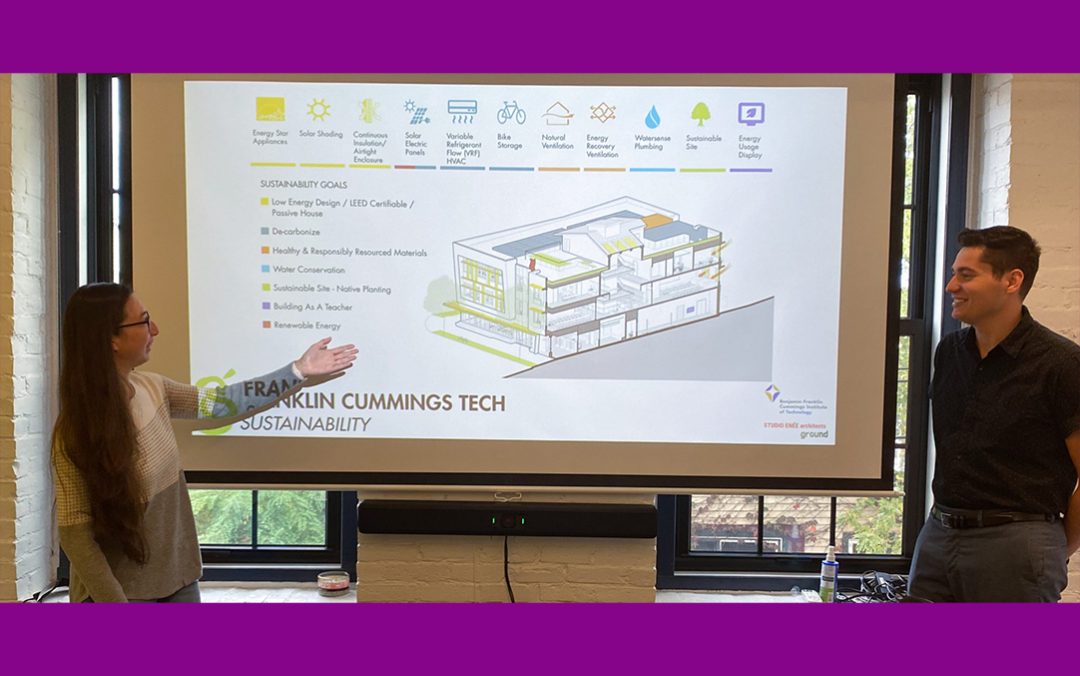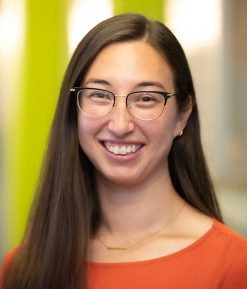
Studio G’s Ali Horwitz and Sam Maloney recently visited a class at UMass Amherst’s Mount Ida Campus in Newton, where they presented the Franklin Cummings Tech (FCT) project and engaged with the students on designs of their own making.
A recent Building Green article discusses the need for high-quality affordable housing, and this notion can be applied to FCT’s educational community as well. Like the needs in affordable housing, FCT is designed to be a durable, healthy environment where students can learn and grow. Sam and Ali helped bring this idea to these high schoolers, as they’re the next generation thinking about the human impact of design.
The high school students, ranging from rising sophomores to seniors, participated in a two-week summer course for college credit called the Diversity in Design Outreach Program. Ali and Sam led their presentation by introducing themselves and their paths into architecture, then went into the details of the FCT project “in terms of programs, the mission of the school, and design,” Sam said.
“It was awesome to see faces light up when we showed particular slides. As someone who worked on [the FCT project], but also as someone who sat in a seat like that (as a high school student interested in the AEC industry), I can so deeply relate to those moments.”
He continued, “We really wanted to highlight how advanced this project is in its thinking, its sustainable efforts, its drive toward equity and social justice, [and] in its participation of majority-minority and women-owned businesses.”
Sam said he felt it was essential to provide this kind of language to high school students and to “set them up with a basepoint that assumes women are architects; that queer people are a part of the construction industry.”
Ali said her goal for visiting this class was a hope “to keep that interest going and to show [the students] that architecture is a viable career path, and hopefully to show that it’s also not just buildings,” she said. “There’s a lot of opportunity within the field of architecture – it doesn’t have to be a narrow path.”
“There is a lot of pressure in that stage of life to make decisions,” Sam said. “I really appreciate the way in which Ali contributed to the conversation.”
“It always helps to see someone who’s well into their career but not very senior,” Ali said, as this can be more relatable to students.
Sam added that for him, “part of the goal was to show them the impact of this particular project; the impact that it’s going to have on a community,” as well as the impact it has on his and Ali’s careers.
After Sam and Ali’s presentation on FCT, the students had the opportunity to present their work and ask for feedback. The students were working in groups of four to five on a model of a house. competing against each other with the intent to keep the temperature inside their house “as consistent as possible,” Ali said. This taught them about things like insulation, green roofs, and solar orientation.
Ali mentioned that the professor had told the students that two design professionals would be coming to speak with them, and many were anxious or nervous to present.
“There was this assumption that architects are hypercritical in an unconstructive way,” Sam said. “I have made a conscious effort to actively address and counteract that assumption,” he said. “That is not at all the profession that I want to be a part of.”
Sam and Ali believe they dispelled that worry in the students, and once they did, the students “seemed much more comfortable to share their projects.”
When walking around and looking at the group projects, Ali and Sam asked probing questions, such as, “what do you think you would do next?” and “is this the best strategy to accomplish your goal.”
“They were really engaged when we were in the classroom,” Sam said.
Sam and Ali both said they learned a lot from this experience.
“Our office has presented this information [on FCT] to lots of different groups: stakeholders, the real estate sector, donors, and other designers, but this was only the second time that the project had been presented to high schoolers,” he said, the first being when Studio G’s Managing Principal Gail Sullivan and Project Manager Gabriela Shelburne presented to a different class of the same program last year.
“This presentation came after the completion of our construction documents,” Sam said, so “a lot more technical information,” as well as information on financing, was available to present. He said the presentation was “intentionally molded” towards high schoolers and how they can best absorb the information.
Sam said that he learned that “In preparation for this presentation, we adapted a slide deck that had previously been used for industry professionals. We wanted to introduce the students to a lot of new content while trying to keep the information accessible to what we assumed was a high-school student’s interest and knowledge base. We were pleasantly surprised when some students had questions about accessibility that we had not expected, and this challenged our assumptions of what the students knew and what they cared about. The way we present information changes based on our assumptions about the audience. My takeaway from this experience was that the next generation of designers is thinking very critically about the human impacts of our/their built work.”
Ali said she appreciated the participation of the students and their thoughtful questions. She also mentioned that they were particularly interested in sustainability and accessibility. “It just felt really good,” she said. “Here’s the next generation.”

